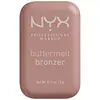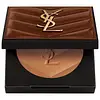What's inside
What's inside
 Key Ingredients
Key Ingredients

 Benefits
Benefits

 Concerns
Concerns

 Ingredients Side-by-side
Ingredients Side-by-side

Mica
Cosmetic ColorantTalc
AbrasiveCI 77891
Cosmetic ColorantCI 77492
Cosmetic ColorantSilica
AbrasiveLauroyl Lysine
Skin ConditioningEthylhexyl Palmitate
EmollientTrimethylsiloxyphenyl Dimethicone
CI 77491
Cosmetic ColorantCI 77499
Cosmetic ColorantZinc Stearate
Cosmetic ColorantOctyldodecanol
EmollientMangifera Indica Seed Butter
Skin ConditioningHelianthus Annuus Seed Oil
EmollientPrunus Amygdalus Dulcis Oil
Skin ConditioningButyrospermum Parkii Butter
Skin ConditioningCaprylyl Glycol
EmollientIsostearyl Isostearate
EmollientOctyldodecyl Stearoyl Stearate
EmollientTocopherol
AntioxidantPhenoxyethanol
PreservativeCI 15850
Cosmetic ColorantParfum
MaskingMica, Talc, CI 77891, CI 77492, Silica, Lauroyl Lysine, Ethylhexyl Palmitate, Trimethylsiloxyphenyl Dimethicone, CI 77491, CI 77499, Zinc Stearate, Octyldodecanol, Mangifera Indica Seed Butter, Helianthus Annuus Seed Oil, Prunus Amygdalus Dulcis Oil, Butyrospermum Parkii Butter, Caprylyl Glycol, Isostearyl Isostearate, Octyldodecyl Stearoyl Stearate, Tocopherol, Phenoxyethanol, CI 15850, Parfum
Talc
AbrasiveSilica
AbrasivePerlite
AbsorbentCaprylic/Capric Triglyceride
MaskingBoron Nitride
AbsorbentOctyldodecyl Stearoyl Stearate
EmollientMagnesium Stearate
Cosmetic ColorantSynthetic Fluorphlogopite
Caprylyl Glycol
EmollientNiacinamide
SmoothingSodium Hyaluronate
HumectantTin Oxide
AbrasiveCitrus Limon Peel Extract
EmollientCI 77491
Cosmetic ColorantCI 77492
Cosmetic ColorantCI 77499
Cosmetic ColorantCI 77891
Cosmetic ColorantIngredients Explained
These ingredients are found in both products.
Ingredients higher up in an ingredient list are typically present in a larger amount.
Caprylyl Glycol is a humectant and emollient, meaning it attracts and preserves moisture.
It is a common ingredient in many products, especially those designed to hydrate skin. The primary benefits are retaining moisture, skin softening, and promoting a healthy skin barrier.
Though Caprylyl Glycol is an alcohol derived from fatty acids, it is not the kind that can dry out skin.
This ingredient is also used as a preservative to extend the life of products. It has slight antimicrobial properties.
Learn more about Caprylyl GlycolCi 77491 is also hydrated iron III oxide. It's sole purpose is to give a red/pink hue to products.
Iron III oxides are classified as inorganic chemicals for coloring.
Synthetically created Ci 77491 is considered safer than those naturally found. This is because the synthetically created version may contain less impurities. Iron oxides are generally non-toxic and non-allergenic.
Learn more about CI 77491Ci 77492 is also hydrated iron III oxide. It's sole purpose is to give a yellow hue to products.
Iron III oxides are classified as inorganic chemicals for coloring.
Synthetically created Ci 77492 is considered safer than those naturally found. This is because the synthetically created version may contain less impurities. Iron oxides are generally non-toxic and non-allergenic.
Learn more about CI 77492Ci 77499 is also hydrated iron III oxide. It is created from mixing red and black iron oxides. This helps give shades of darkness to a product.
Iron III oxides are classified as inorganic chemicals for coloring.
Ci 77891 is a white pigment from Titanium dioxide. It is naturally found in minerals such as rutile and ilmenite.
It's main function is to add a white color to cosmetics. It can also be mixed with other colors to create different shades.
Ci 77891 is commonly found in sunscreens due to its ability to block UV rays.
Learn more about CI 77891Octyldodecyl Stearoyl Stearate is created from stearic acid.
It is an emollient and thickens the lipid (oil) portion of a product. Due to its emollient properties, it may not be fungal-acne safe.
Silica, also known as silicon dioxide, is a naturally occurring mineral. It is used as a fine, spherical, and porous powder in cosmetics.
Though it has exfoliant properties, the function of silica varies depending on the product.
The unique structure of silica enhances the spreadability and adds smoothness, making it a great texture enhancer.
It is also used as an active carrier, emulsifier, and mattifier due to its ability to absorb excess oil.
In some products, tiny microneedles called spicules are made from silica or hydrolyzed sponge. When you rub them in, they lightly polish away dead skin layers and enhance the penetration of active ingredients.
Learn more about SilicaTalc is a clay mineral. It helps absorb moisture and improve the texture of products. Like other types of clay, Talc can have a slight exfoliating effect on skin. Talc can be added to increase the volume of products.
Some Baby powders are made by combining talc with corn starch. The word "talc" comes from Latin and originates from Arabic. Talc is a mineral commonly found throughout the world.
If you have any concerns about using talc, we recommend checking out the FDA's official page.
Learn more about Talc